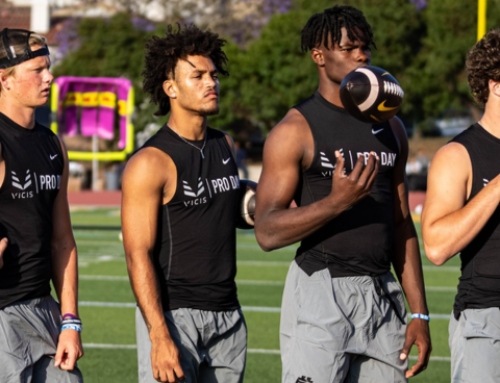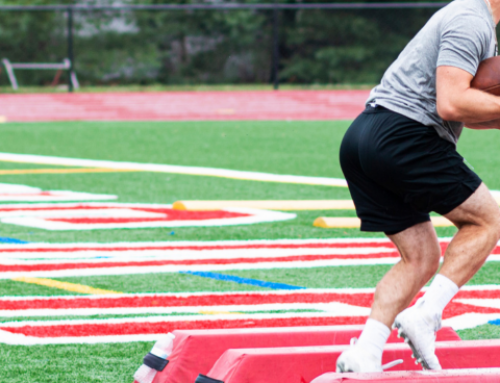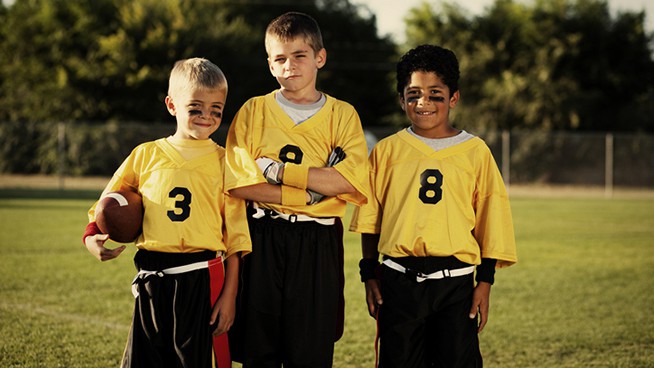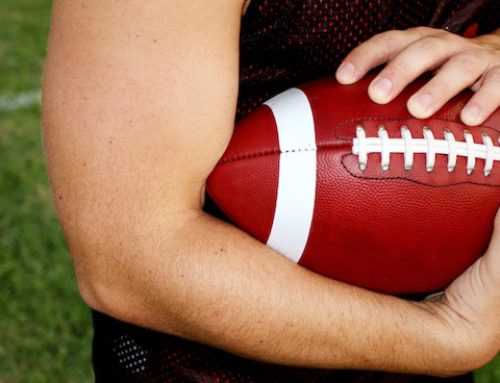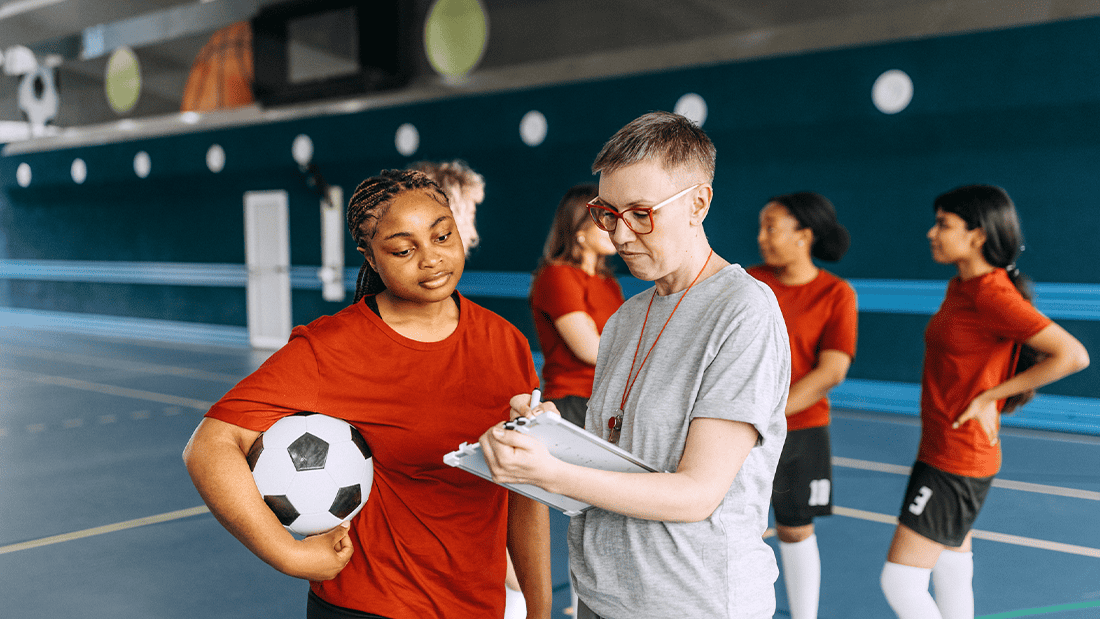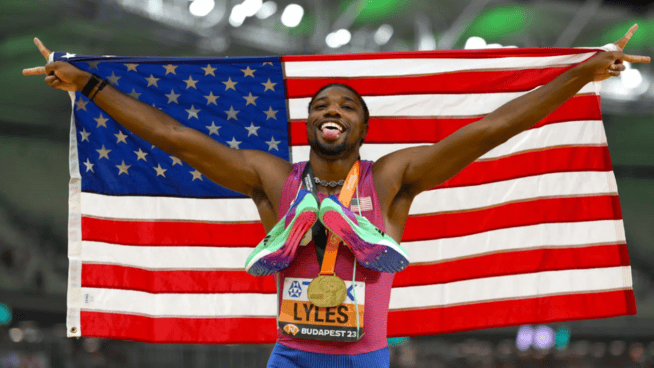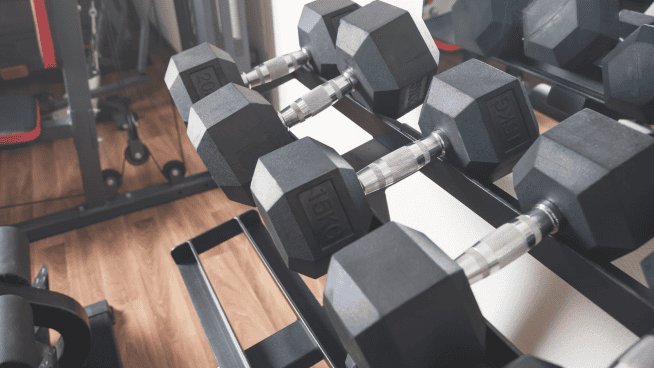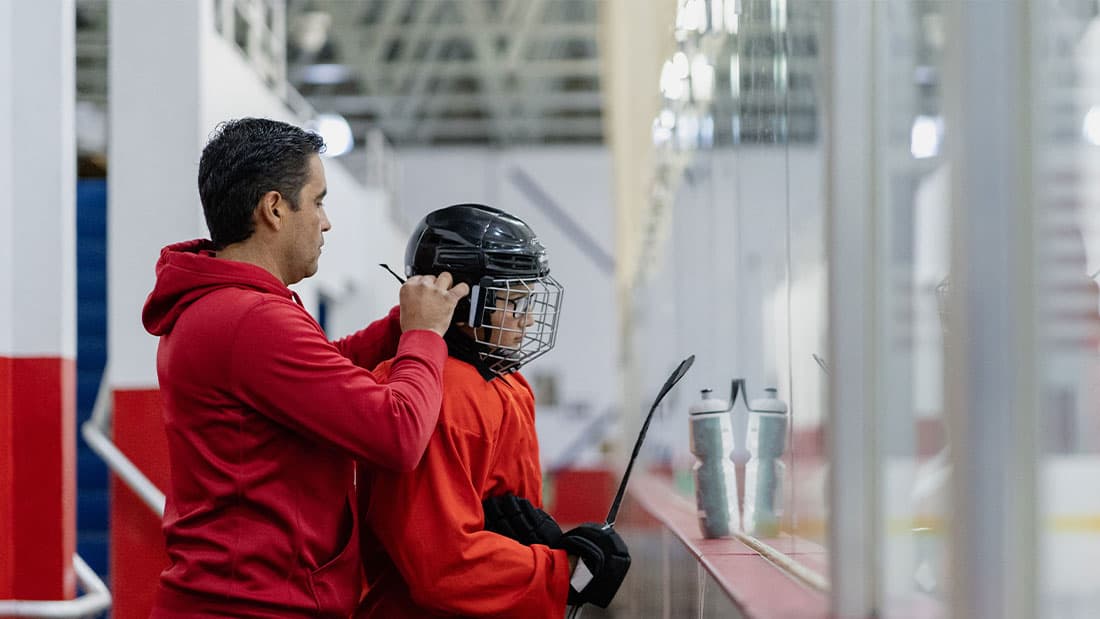Nose tackles aren’t supposed to stuff the stat sheet.
Tasked with lining up directly over the center, your typical nose tackle is chiefly concerned with gobbling up double- and triple-teams to free up space for their teammates. It’s about as unglamorous a football position can get.
That’s what makes what Harrison Phillips did in 2017 so darn impressive. Lining up primarily at nose tackle for the Stanford Cardinal, Phillips totaled a team-leading 103 tackles. For context, any number north of 50 tackles is considered a strong season of production for the position. Phillips doubled that and then some, earning himself AP All-America third-team honors and shooting up NFL big boards in the process. One reason he was such a nightmare for offensive linemen to handle? His background as a wrestler.
“The physical parallels of hips, hands, fluidity, balance, things like that. But there’s also the mentality part. In wrestling, it’s you and another person. You can’t blame your shoes for slipping, you can’t blame your coaches for the play call, you can’t have any excuses. You let another man beat you. That kinda is the trenches,” Phillips said at the 2018 NFL Combine of his wrestling background. “If my kids want to be football players, I’m going to have them wrestle.”
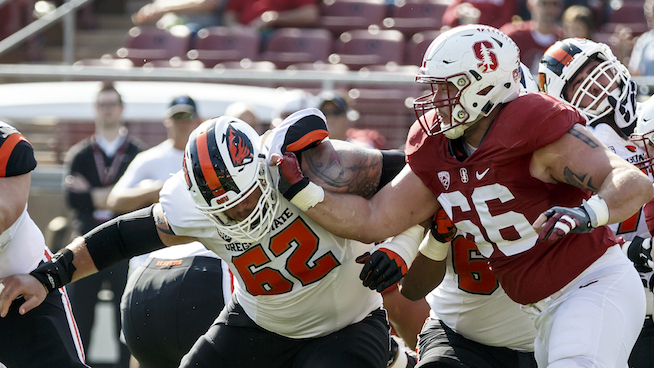
Phillips’ education on the mat began when he was just 3 years old. After being born in the 99th percentile for height and weight, Phillips had grown into a massive toddler. He was a big ball of energy, so his parents, Paul and Tammie Phillips, searched for a productive outlet. After speaking with a couple of wrestling coaches at their church, they decided to take Harrison to some practices.
“Typically, they don’t advise people to come wrestle at 3 years old. But I was as big as the 5- and 6-year-olds, so the coaches figured, ‘Why don’t we just throw him in?’ Phillips told STACK. One problem—he simply didn’t have any opponents his size at his age. That meant almost exclusively matching up against grapplers several years older than himself. Dealing with a huge age disadvantage, the results were predictable—Phillips lost almost every match.
“From 3 to 8 years old, I was not even close to having a winning record. It wasn’t because I was bad, it was because I was big. There was no one my age to wrestle,” Philips says. “There were no 6-year-olds who weighed 65 pounds, but there were 5th and 6th graders who did. At 6 years old, I’m wrestling a 12-year-old. Obviously, he’s going to kill me…there was a season where I didn’t win a match.”
While Phillips took a beating in many of his bouts, his parents always found a positive to highlight. That mindset helped Phillips focus on getting better every match as opposed to obsessing about wins and losses.
“After getting my butt kicked on the mat, they’d say, ‘Wow, your stance was so much better this match’ or ‘you circled in the mat so much better’ or ‘last match you didn’t shoot at all, this match you shot twice’. They always found something that I improved on and celebrated those things,” Phillips says. “Obviously losing sucks, but at that age, you’re so young. It’s not as important if you’re winning or losing. And my parents made that clear and made it more about having fun.”
When Phillips began adding other sports to his schedule, he found the skills he had built on the mat gave him an instant edge. Whether it be using his hips and hands in concert on a baseball swing or his conditioning and endurance during a soccer match, the cross-training effects of wrestling were evident. “I was leaps and bounds ahead of other people just because I had used my body in those weird ways (you do with wrestling) before,” Phillips says. “I’d also been coached before. I understood when to talk, when not to talk, what to do, what not to do. It just made all other sports way easier.”
As more kids got into wrestling and Phillips suddenly found opponents in his weight class closer to his age, he began enjoying a lot more victories. “One year I went like 5-20, then I went 20-5 the next year. It was these kids’ first year wrestling, but it was my 6th or 7th year wrestling. I had all these moves, I knew the right things to do,” Philips says. “There wasn’t a year from when I was 8 until I graduated high school where I lost more than four or five matches.”
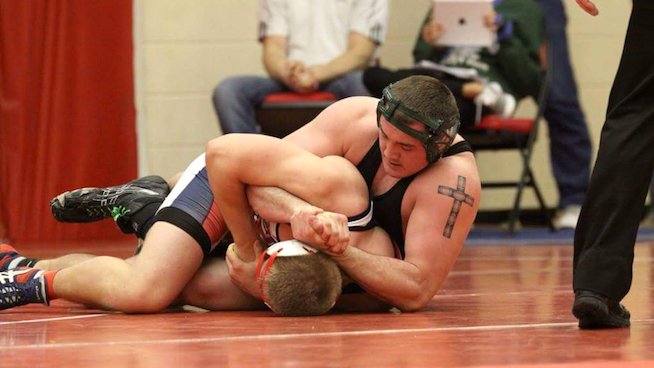
By the time Phillips arrived at Millard West High School (Omaha, Nebraska) to wrestle for coach Scott Townsley, he was a phenom. All those years going up against older, stronger opponents had taught him how to best leverage his own strength and made his technique razor sharp. Wrestling at the 189-pound weight class, Phillips often found himself up against fully developed athletes as a freshman.
“At 106 pounds and 112 pounds, it’s very common to have freshmen do well. Just because it’s such a small weight class, it’s hard for a high school senior to be that small. But 190 pounds is a grown man weight class. (Some people) say that 180 to 190 is the toughest weight class in high school, because you have these kids who are just cut up 18-year-old men with full ride scholarships to wrestle or play football,” Phillips says. “I was long, lanky, no definition, no facial hair, nothing. That freshman year was so big for me. I came all the way to the state championship and got a concussion in the state semis and couldn’t compete and had to withdraw.”
While Philips was at a strength and development disadvantage at the 189-pound weight class, he found himself at a distinct weight disadvantage when he moved up to heavyweight ahead of his sophomore season. The heavyweight class requires wrestlers to weigh in at between 220 and 285, and Philips almost always found himself giving up some serious pounds to his competition. However, Phillips’ earlier wrestling experience had helped him develop an approach almost never seen in the heavyweight division. While most heavyweight battles consist of two giants stalemating for position with an occasional point being scored, Phillips wrestled like a man on fire.
“Sophomore year, junior year, senior year, I wrestled heavyweight. The cutoff was 285. So wrestling at 230 or 240, it was just speed and athleticism as well as technique,” Phillips says. “You watch my matches, I’d be moving like the 145-pound kids, taking 12 shots a minute. These other heavyweights, they’d never seen anything like that, they get tired. They didn’t even know how to wrestle someone like me. I attribute that to the fact I wrestled so many different people growing up, it just taught me different wrestling styles other than the typical heavyweight.”
While heavyweight matches usually grind to a final score akin to a soccer match (3-1, 4-2, etc.), Phillips would often “tech” opponents by gaining a lead of 15 points, at which point the match is called immediately (think of it like wrestling’s equivalent of the mercy rule).
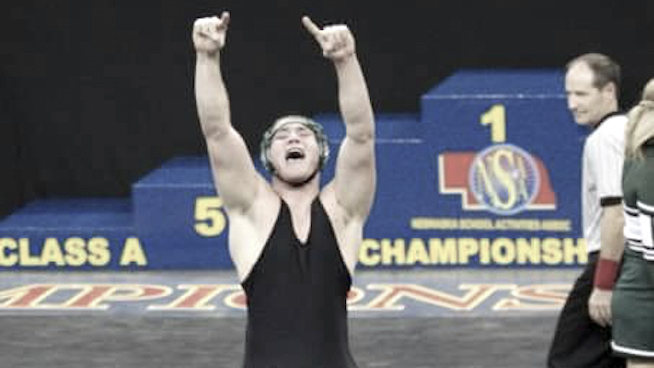
Phillips became so dominant that his coaches at Millard West began blindfolding him before he’d wrestle his teammates, yet Harrison would still manage to gain the upper hand. He went on to win a Nebraska Class A state wrestling championship as a sophomore—a feat he’d repeat in both his junior and senior years. By the time his high school wrestling career was over, he’d set a school record for takedowns. While his wrestling background has long fueled his success on the gridiron, it was perhaps most evident in his play as a true freshman at Stanford.
Phillips was recruited as a defensive end and arrived on campus at 252 pounds. But when both the starting and second-string nose tackles went down with injuries, Phillips was thrust into the rotation. Not only was he a good 60 to 70 pounds lighter than your run-of-the-mill nose tackle, but he knew very little about the technique needed to play the position. But thanks to his wrestling expertise, Phillips was able to hold his own. He’d often find himself contorted in bizarre positions by offensive linemen, only to maintain his balance and eventually shed his blocker. His jaw-dropping flexibility (Phillips has been known to bust out a full split on command) both perplexed and impressed the Cardinal coaching staff.
“There were so many positions that coaches would just cringe at—‘You have one foot in the ground, one hand over your head, the other foot is almost doing the split. Doesn’t that hurt?’ I’m like, ‘No, I feel comfortable there,’” Phillips says. “Then they let the play roll and I swim off the block and make a tackle. Just going from these bizarre positions where I felt comfortable, and that was completely due to wrestling. All the scrambling and weird situations and core strength it requires, I felt comfortable in positions most people didn’t.”
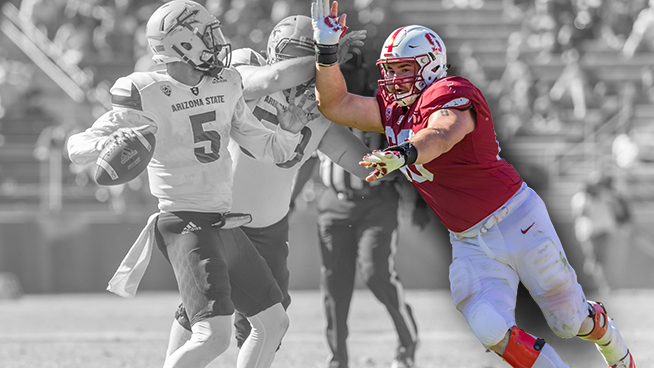
As Phillips bulked up over his college career, he went from simply surviving at nose tackle to thriving there. Over his final two seasons on The Farm, Phillips totaled 149 tackles, 26.5 tackles for loss, 14 sacks and two forced fumbles. His NFL.com scouting profile is littered with references to his former sport, with Lance Zierlein writing “background as scrambler in wrestling makes it hard for offensive linemen to finish their blocks against him” and “three-time high school wrestling champ with strong core and power to torque blockers from his hips.”
As much as wrestling has helped Phillips in the physical aspects of football, he believes how the sport developed him mentally is just as important. “When I got to high school, (a wrestling match) was life or death. It really felt like the Roman coliseum, being two gladiators out there and one of us was going to walk off and one of us was not,” Phillips says. “It’s all on you. That mindset I had with wrestling I tried to carry over to the trenches with football.”
While wrestling has natural crossover to line play, Phillips believes the sport would be a beneficial cross-training option for skill positions, as well. “If you want to think of it simply, it’s just another training style. You’re working on getting stronger, having a stronger core, having better balance…if you’re a receiver who wrestled in high school, he’ll know how to block. The best safeties I ever played with in high school were wrestlers, because they knew how to come down and hit somebody with a blast double and really lay the wood,” Phillips says. “Shoot, even quarterbacks—shoulder strength, being able to rotate with your hips, all the footwork. So much of wrestling is just footwork, and every single football position deals with footwork. I don’t think there’s a position on the field that wouldn’t benefit from wrestling.”
Photo Credit: David Madison/Getty Images, Allan Hamilton/Getty Images
READ MORE:
RECOMMENDED FOR YOU
MOST POPULAR
Nose tackles aren’t supposed to stuff the stat sheet.
Tasked with lining up directly over the center, your typical nose tackle is chiefly concerned with gobbling up double- and triple-teams to free up space for their teammates. It’s about as unglamorous a football position can get.
That’s what makes what Harrison Phillips did in 2017 so darn impressive. Lining up primarily at nose tackle for the Stanford Cardinal, Phillips totaled a team-leading 103 tackles. For context, any number north of 50 tackles is considered a strong season of production for the position. Phillips doubled that and then some, earning himself AP All-America third-team honors and shooting up NFL big boards in the process. One reason he was such a nightmare for offensive linemen to handle? His background as a wrestler.
“The physical parallels of hips, hands, fluidity, balance, things like that. But there’s also the mentality part. In wrestling, it’s you and another person. You can’t blame your shoes for slipping, you can’t blame your coaches for the play call, you can’t have any excuses. You let another man beat you. That kinda is the trenches,” Phillips said at the 2018 NFL Combine of his wrestling background. “If my kids want to be football players, I’m going to have them wrestle.”

Phillips’ education on the mat began when he was just 3 years old. After being born in the 99th percentile for height and weight, Phillips had grown into a massive toddler. He was a big ball of energy, so his parents, Paul and Tammie Phillips, searched for a productive outlet. After speaking with a couple of wrestling coaches at their church, they decided to take Harrison to some practices.
“Typically, they don’t advise people to come wrestle at 3 years old. But I was as big as the 5- and 6-year-olds, so the coaches figured, ‘Why don’t we just throw him in?’ Phillips told STACK. One problem—he simply didn’t have any opponents his size at his age. That meant almost exclusively matching up against grapplers several years older than himself. Dealing with a huge age disadvantage, the results were predictable—Phillips lost almost every match.
“From 3 to 8 years old, I was not even close to having a winning record. It wasn’t because I was bad, it was because I was big. There was no one my age to wrestle,” Philips says. “There were no 6-year-olds who weighed 65 pounds, but there were 5th and 6th graders who did. At 6 years old, I’m wrestling a 12-year-old. Obviously, he’s going to kill me…there was a season where I didn’t win a match.”
While Phillips took a beating in many of his bouts, his parents always found a positive to highlight. That mindset helped Phillips focus on getting better every match as opposed to obsessing about wins and losses.
“After getting my butt kicked on the mat, they’d say, ‘Wow, your stance was so much better this match’ or ‘you circled in the mat so much better’ or ‘last match you didn’t shoot at all, this match you shot twice’. They always found something that I improved on and celebrated those things,” Phillips says. “Obviously losing sucks, but at that age, you’re so young. It’s not as important if you’re winning or losing. And my parents made that clear and made it more about having fun.”
When Phillips began adding other sports to his schedule, he found the skills he had built on the mat gave him an instant edge. Whether it be using his hips and hands in concert on a baseball swing or his conditioning and endurance during a soccer match, the cross-training effects of wrestling were evident. “I was leaps and bounds ahead of other people just because I had used my body in those weird ways (you do with wrestling) before,” Phillips says. “I’d also been coached before. I understood when to talk, when not to talk, what to do, what not to do. It just made all other sports way easier.”
As more kids got into wrestling and Phillips suddenly found opponents in his weight class closer to his age, he began enjoying a lot more victories. “One year I went like 5-20, then I went 20-5 the next year. It was these kids’ first year wrestling, but it was my 6th or 7th year wrestling. I had all these moves, I knew the right things to do,” Philips says. “There wasn’t a year from when I was 8 until I graduated high school where I lost more than four or five matches.”

By the time Phillips arrived at Millard West High School (Omaha, Nebraska) to wrestle for coach Scott Townsley, he was a phenom. All those years going up against older, stronger opponents had taught him how to best leverage his own strength and made his technique razor sharp. Wrestling at the 189-pound weight class, Phillips often found himself up against fully developed athletes as a freshman.
“At 106 pounds and 112 pounds, it’s very common to have freshmen do well. Just because it’s such a small weight class, it’s hard for a high school senior to be that small. But 190 pounds is a grown man weight class. (Some people) say that 180 to 190 is the toughest weight class in high school, because you have these kids who are just cut up 18-year-old men with full ride scholarships to wrestle or play football,” Phillips says. “I was long, lanky, no definition, no facial hair, nothing. That freshman year was so big for me. I came all the way to the state championship and got a concussion in the state semis and couldn’t compete and had to withdraw.”
While Philips was at a strength and development disadvantage at the 189-pound weight class, he found himself at a distinct weight disadvantage when he moved up to heavyweight ahead of his sophomore season. The heavyweight class requires wrestlers to weigh in at between 220 and 285, and Philips almost always found himself giving up some serious pounds to his competition. However, Phillips’ earlier wrestling experience had helped him develop an approach almost never seen in the heavyweight division. While most heavyweight battles consist of two giants stalemating for position with an occasional point being scored, Phillips wrestled like a man on fire.
“Sophomore year, junior year, senior year, I wrestled heavyweight. The cutoff was 285. So wrestling at 230 or 240, it was just speed and athleticism as well as technique,” Phillips says. “You watch my matches, I’d be moving like the 145-pound kids, taking 12 shots a minute. These other heavyweights, they’d never seen anything like that, they get tired. They didn’t even know how to wrestle someone like me. I attribute that to the fact I wrestled so many different people growing up, it just taught me different wrestling styles other than the typical heavyweight.”
While heavyweight matches usually grind to a final score akin to a soccer match (3-1, 4-2, etc.), Phillips would often “tech” opponents by gaining a lead of 15 points, at which point the match is called immediately (think of it like wrestling’s equivalent of the mercy rule).

Phillips became so dominant that his coaches at Millard West began blindfolding him before he’d wrestle his teammates, yet Harrison would still manage to gain the upper hand. He went on to win a Nebraska Class A state wrestling championship as a sophomore—a feat he’d repeat in both his junior and senior years. By the time his high school wrestling career was over, he’d set a school record for takedowns. While his wrestling background has long fueled his success on the gridiron, it was perhaps most evident in his play as a true freshman at Stanford.
Phillips was recruited as a defensive end and arrived on campus at 252 pounds. But when both the starting and second-string nose tackles went down with injuries, Phillips was thrust into the rotation. Not only was he a good 60 to 70 pounds lighter than your run-of-the-mill nose tackle, but he knew very little about the technique needed to play the position. But thanks to his wrestling expertise, Phillips was able to hold his own. He’d often find himself contorted in bizarre positions by offensive linemen, only to maintain his balance and eventually shed his blocker. His jaw-dropping flexibility (Phillips has been known to bust out a full split on command) both perplexed and impressed the Cardinal coaching staff.
“There were so many positions that coaches would just cringe at—‘You have one foot in the ground, one hand over your head, the other foot is almost doing the split. Doesn’t that hurt?’ I’m like, ‘No, I feel comfortable there,’” Phillips says. “Then they let the play roll and I swim off the block and make a tackle. Just going from these bizarre positions where I felt comfortable, and that was completely due to wrestling. All the scrambling and weird situations and core strength it requires, I felt comfortable in positions most people didn’t.”

As Phillips bulked up over his college career, he went from simply surviving at nose tackle to thriving there. Over his final two seasons on The Farm, Phillips totaled 149 tackles, 26.5 tackles for loss, 14 sacks and two forced fumbles. His NFL.com scouting profile is littered with references to his former sport, with Lance Zierlein writing “background as scrambler in wrestling makes it hard for offensive linemen to finish their blocks against him” and “three-time high school wrestling champ with strong core and power to torque blockers from his hips.”
As much as wrestling has helped Phillips in the physical aspects of football, he believes how the sport developed him mentally is just as important. “When I got to high school, (a wrestling match) was life or death. It really felt like the Roman coliseum, being two gladiators out there and one of us was going to walk off and one of us was not,” Phillips says. “It’s all on you. That mindset I had with wrestling I tried to carry over to the trenches with football.”
While wrestling has natural crossover to line play, Phillips believes the sport would be a beneficial cross-training option for skill positions, as well. “If you want to think of it simply, it’s just another training style. You’re working on getting stronger, having a stronger core, having better balance…if you’re a receiver who wrestled in high school, he’ll know how to block. The best safeties I ever played with in high school were wrestlers, because they knew how to come down and hit somebody with a blast double and really lay the wood,” Phillips says. “Shoot, even quarterbacks—shoulder strength, being able to rotate with your hips, all the footwork. So much of wrestling is just footwork, and every single football position deals with footwork. I don’t think there’s a position on the field that wouldn’t benefit from wrestling.”
Photo Credit: David Madison/Getty Images, Allan Hamilton/Getty Images
READ MORE:

